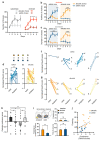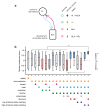Reciprocal cortico-amygdala connections regulate prosocial and selfish choices in mice
- PMID: 36280797
- PMCID: PMC7613781
- DOI: 10.1038/s41593-022-01179-2
Reciprocal cortico-amygdala connections regulate prosocial and selfish choices in mice
Abstract
Decisions that favor one's own interest versus the interest of another individual depend on context and the relationships between individuals. The neurobiology underlying selfish choices or choices that benefit others is not understood. We developed a two-choice social decision-making task in which mice can decide whether to share a reward with their conspecifics. Preference for altruistic choices was modulated by familiarity, sex, social contact, hunger, hierarchical status and emotional state matching. Fiber photometry recordings and chemogenetic manipulations demonstrated that basolateral amygdala (BLA) neurons are involved in the establishment of prosocial decisions. In particular, BLA neurons projecting to the prelimbic (PL) region of the prefrontal cortex mediated the development of a preference for altruistic choices, whereas PL projections to the BLA modulated self-interest motives for decision-making. This provides a neurobiological model of altruistic and selfish choices with relevance to pathologies associated with dysfunctions in social decision-making.
© 2022. The Author(s), under exclusive licence to Springer Nature America, Inc.
Conflict of interest statement
The authors declare that they have no competing interests.
Figures

















Comment in
-
Altruism and social rewards.Nat Neurosci. 2022 Nov;25(11):1405-1406. doi: 10.1038/s41593-022-01190-7. Nat Neurosci. 2022. PMID: 36280800 No abstract available.
References
-
- Rilling JK, King-Casas B, Sanfey AG. The neurobiology of social decision-making. Curr Opin Neurobiol. 2008;18:159–165. - PubMed
-
- Batson CD. The naked emperor: Seeking a more plausible genetic basis for psychological altruism. Econ Philos. 2010 doi: 10.1017/S0266267110000179. - DOI
-
- Marsh AA. Neural, cognitive, and evolutionary foundations of human altruism. Wiley Interdiscip Rev Cogn Sci. 2016;7:59–71. - PubMed
Publication types
MeSH terms
Associated data
LinkOut - more resources
Full Text Sources
Other Literature Sources

